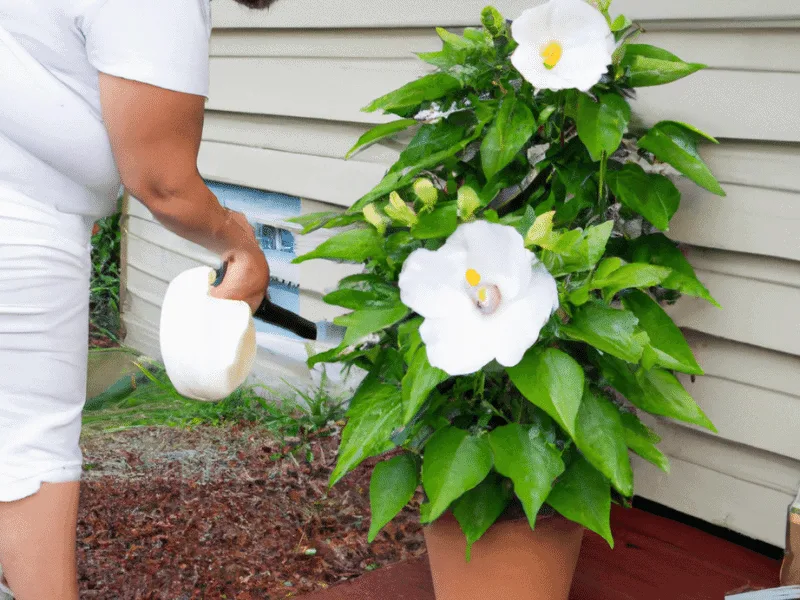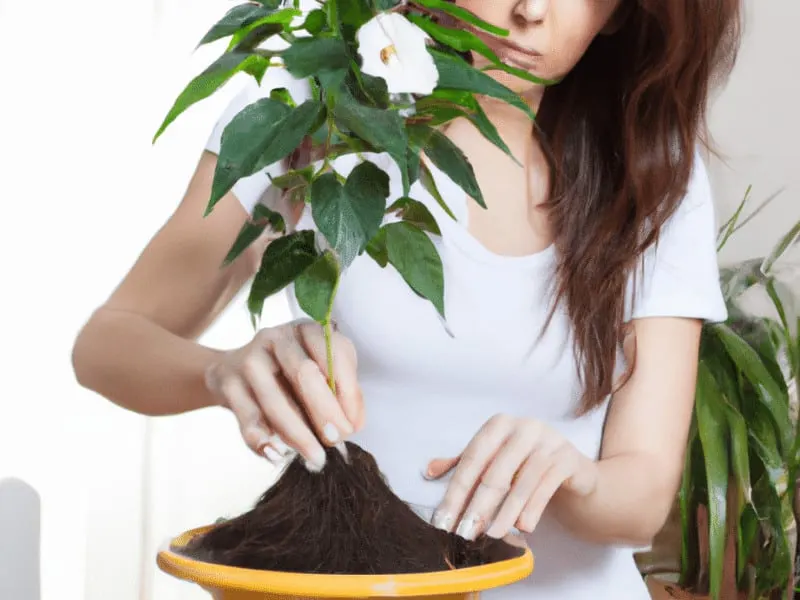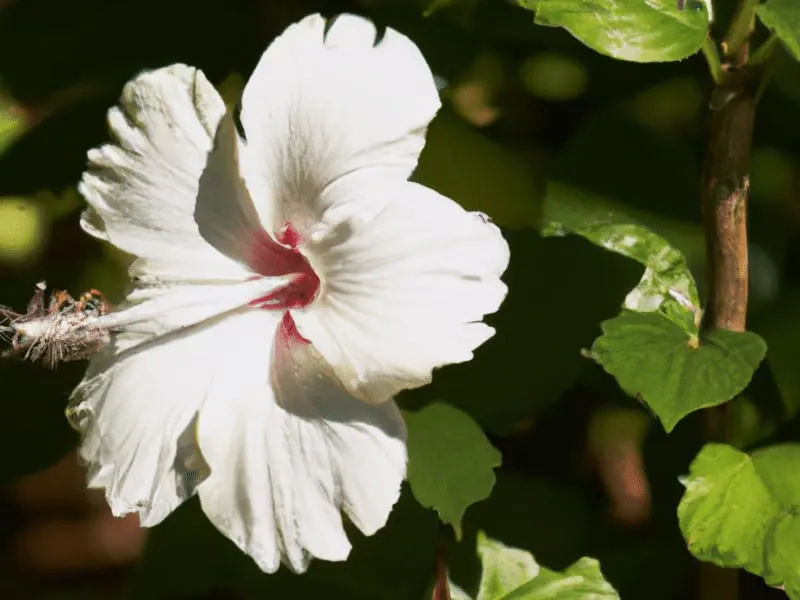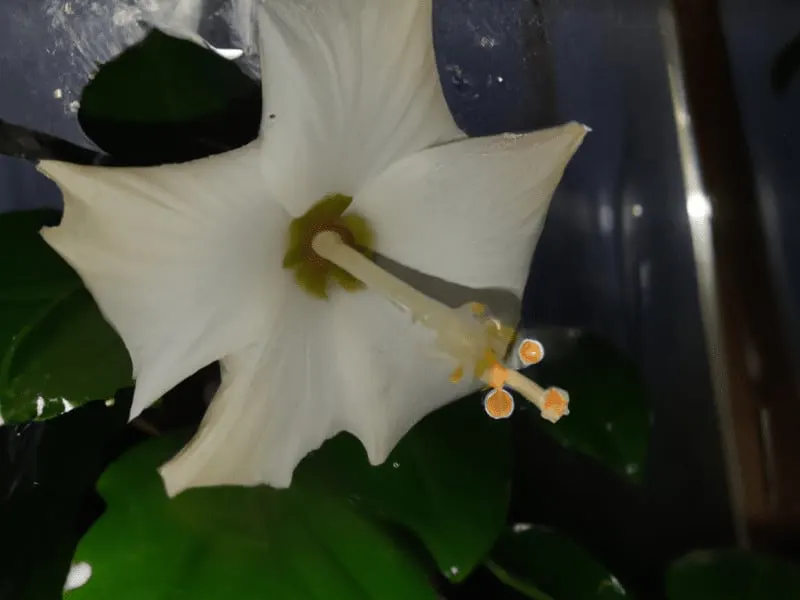A member of the mallow or Malvaceae family, the hibiscus is a flowering subtropical plant known for its beautiful blooms with 5 petals according to Santhi Online.
Hibiscus flowers come in almost every color you can think of and are especially popular in shades of red, pink, and orange.
In this article, we are going to focus on the white hibiscus plant, and outline how to give it the best care possible.
The white hibiscus plant is notable for how deeply saturated it is and often has contrasting spots of deep pink or red in the center of it.
Many think that the hibiscus species is a difficult plant to care for, but by reading the information below you will find out that this isn’t entirely true!
Like most plants, it comes with the occasional issues, but this plant can be easily cared for by even the most novice gardener.
Read on to find out everything you need to know about white hibiscus plant care!
White Hibiscus Care
White hibiscus plants thrive in moist, warm, and humid conditions, preferring temperates of between 60-90ºF (16-32ºC). It will struggle in low temperatures or if planted in heavy soil. Foliage and blooms should be checked regularly for signs of pests or disease and should be treated immediately with pesticides.

White Hibiscus Care
Table of Contents
White Hibiscus Care Guide
Watering White Hibiscus
Hibiscus enjoys soil that is moist, but not soggy. This can often make it quite difficult for new plant owners to find the right balance in watering.
It is impossible to create a timed schedule when it comes to watering hibiscus.
For example, I water my plant once a week, but if you live in an environment that is much warmer or cooler, you would need to water your hibiscus either more or less frequently.
I would suggest using the touch test technique to know when you should water your hibiscus next. Every few days, use a popsicle stick (or even just your finger) to make a hole in the soil of around 2-3 inches.
If the undersoil should be very slightly moist and the topsoil almost completely dry, that means it is the perfect time for your hibiscus to be watered again.
Top tip – only water your hibiscus during the early morning or late evening when the sun is no longer direct.
Watering during direct sunlight hours unless seriously needed would be very counterproductive, as it is likely that the water will evaporate before it your hibiscus can fully benefit from it.

Watering White Hibiscus
The Right Soil For White Hibiscus
Choosing the right soil for your white hibiscus is key. Hibiscus prefers soil that is slightly acidic, a little below a 7 on the pH scale.
You can test the pH scale of your hibiscus’ soil by purchasing pH testing strips online, or by sending a sample of the soil to a testing lab.
If your soil is below the white hibiscus’ preferred pH scale, I would suggest adding compost that is rich in organic matter to raise the acidic levels.
Similarly, you can purchase garden or dolomite lime to treat soil that has a very high level of acid in it.
You should also ensure that the soil type you are using is both well-draining and has moisture-retaining qualities.
I would strongly advise against using heavy soil, such as compost or a clay-based mix, as this could cause water to become clogged in the soil, which could result in root issues for your plant.

White hibiscus prefers slightly acidic soil
Light requirements
Hibiscus plants need at least 4-6 hours of direct sunlight a day to truly thrive. They originate from tropical and subtropical areas of the world, so the more time they can spend in a sunny location – the better!
If your white hibiscus is purely a garden plant, be sure to plant it in an area where sunlight is guaranteed to reach it.
Hibiscus plants that are kept as houseplants should be placed on a bright windowsill, and I would maybe even suggest moving them outside for a few hours a day during peak summer months.

Hibiscus plants need 4-6 hours of direct sunlight a day
Temperature
Hibiscus plants love warm locations. Their flowers hold a lot of moisture, therefore heat and humidity are vital for their growth.
The perfect temperature for hibiscus is said to be anything over 70ºF (21ºC), but I personally think anything above 60ºF (16ºC) is absolutely fine.
It is cooler temperatures that hibiscus plants are much fussier about. I would strongly encourage bringing your hibiscus if the nights are starting to get cooler, and then moving your plant back outside during the warmer daylight hours.
Hibiscus cannot tolerate anything under 35ºF (1.6ºC), and it is likely that your plant will succumb to irreversible damage or even die.
Humidity
The ideal humidity for white hibiscus is between 50-60%. Hibiscus tolerates and thrives under increased humidity as long as it is below 90%. 90% or more humidity is detrimental for plants based on my personal experience.

Hibiscus is a humidity loving plant that grows well in 50-60% humidity
Fertilizer
Fertilize hibiscus once a month in spring and summer using a liquid fertilizer or apply a slow-release fertilizer lasting up to 6 months.
Using fertilizer is a pivotal part of white hibiscus care. It is important that you only fertilize hibiscus during their growth and blooming periods, and not during the cooler months or when they are in dormancy.
There are many fertilizers on the market specifically designed for hibiscus care, but I personally choose to use a granular fertilizer over a liquid one.
This is due to their slow-release properties, meaning that they will keep regularly providing your hibiscus with the nutrients it needs over a period of time.
NPK nutrients are the three most vital nutrients for a hibiscus plant, but when purchasing a fertilizer, you should ensure that there is a higher amount of nitrogen (N) and potash (K) in the soil and just a small amount of phosphate (P).
Propagating White Hibiscus
Taking a Cutting from White Hibiscus
To propagate a hibiscus, start by taking cuttings from a parent plant. These cuttings will then be used to create copies and grow more hibiscus plants.
You should always choose the healthiest plant you have to take cuttings from, as this will mean there will be a higher survival rate.
Choose a stem that has smooth branches and lots of green leaves, but no growth or bloom. Then, cut a length of around 6-8 inches.
The cut should be made at a 45-degree angle and should be made just below a node (or eye) of the stem.
Next, using clean pruning shears, you should start to remove a majority of the bottom leaves from the stem, only leaving a few of the smaller leaves.
This will help improve the oxygen levels of your hibiscus plants as they begin to grow.
Propagating White Hibiscus in Soil
To propagate a white hibiscus plant directly into the soil, you should first treat the freshly cut stems with a rooting hormone.
This will increase the chances of growing a viable new hibiscus plant.
Do so by lightly scoring the very bottom of your cuttings with a pair of clean scissors or a knife, and then dip the bottom inch of the stems into the rooting hormone.
Now your cuttings are ready to be placed into the soil. I suggest using a high-draining soil, such as one mixed with horticultural sand or gravel.
Place the cuttings around 2 inches deep in the soil mix, and pack the soil firmly around the stem. You should start to see signs of growth within as little as 2 weeks.
Propagating White Hibiscus in Water
Another way to propagate your hibiscus is by growing it in water. To do so, start by scratching off 1-2 inches of the bottom of the stem with a clean pruning tool.
Next, fill a glass or jar with water. You should fill it to around 3/4 of the size of your stems, and ensure that no leaves and touching the water.
I would suggest using filtered or distilled water as opposed to tap water, especially if you live in an area that has a particularly high or low pH level.
Change the water every 5 days, and within 10-14 days the roots of your hibiscus cutting should be strong enough to plant into the soil.
Propagating White Hibiscus From Seeds
Hibiscus can also be propagated from seeds. Seeds sprout within 4-5 days provided they get sufficient warmth and humidity.
The ideal temperature and humidity lie between 75-90 degrees Fahrenheit (24-32 degrees Celsius).
It takes between 2-3 months until a hibiscus seedling reaches maturity.
Read our full guide on how to propagate hibiscus from seeds.
Common White Hibiscus Problems
Powdery Mildew Disease on White Hibiscus
Powdery mildew is a fungal disease, that causes white spores of fungus on the foliage of hibiscus. It is usually spread through water hitting the leaves of your plant, sometimes a result of incorrect watering or heavy rainfall.
If caught soon enough it can easily be reversed. There are many fungicides available for purchase from plant nurseries that are specifically designed to treat powdery mildew, but I would personally choose a more natural solution.
Mix 1 tablespoon of Neem oil with half a gallon of water, and add a dash of liquid dish soap. Spray all over the tops and undersides of the leaves once a week until all symptoms have cleared.
White Hibiscus and Aphids
Aphids, also known as “plant lice” are one of the most common hibiscus pests. They are tiny bugs with pear-shaped bodies and can appear in many colors, such as black, gray, or brown.
They will usually live on both the foliage and stems of your hibiscus and will congregate in groups together. They feed on the juices and sap inside your hibiscus’ leaves, causing discoloration and wilting.
If the bugs are left untreated, they could cause the hibiscus to be completely stripped of nutrients and eventually lead to death.
To treat an aphid infestation in the early stages, use a steady stream of water, such as from a hose to knock the bugs off of the leaves.
You could even choose to handpick the bugs from your plant, although this could prove to be a timely process.
Alternatively, a larger infestation can be treated with a soap solution. Mix 2 tablespoons of liquid soap or detergent with a gallon of water, and spray the solution all over the leaves and stems.
Just one application of the soap mixture should kill most of the bugs, but if not you can reapply the mixture after 7-10 days.
Hibiscus Wilt disease
Wilt disease is a disease that, well, causes your white hibiscus plant to wilt. It is the result of a form of fungi called verticillium, which attacks plants from the roots.
It can cause a variety of symptoms, therefore sometimes making it difficult to identify in hibiscus plants. In the early stages, you will notice the leaves becoming yellow and starting to shrivel. As this progresses, the stems and foliage will start to wilt.
Eventually, the branches will begin to experience dieback, which could cause your hibiscus to become completely dead in a very short time.
Frequently Asked Questions About White Hibiscus Care
What is the difference between a hardy and tropical hibiscus?
The hardy hibiscus is perennial, meaning that it blooms during the warmer months and goes into dormancy during the winter. The tropical hibiscus is an evergreen plant, meaning that its leaves remain green throughout the year. When it comes to plant care, both enjoy similar temperatures.
Do hibiscus flowers come back every year?
Hibiscus are perennial plants meaning that they flower and bloom once a year, usually during the spring and summer months.
Should you deadhead a hibiscus?
Deadheading a hibiscus is not a vital part of their care schedule, but it can be done for aesthetic purposes. Usually, after the hibiscus blooms die, they will wilt and fall off of the plant unprompted.
When should I prune my hibiscus?
I would suggest pruning your hibiscus during the spring when your plant is no longer in dormancy but new growth has not yet appeared.
Conclusion To White Hibiscus Care
To care for white hibiscus provide the following:
Temperature: 60-90ºF (16-32ºC)
Humidity: 50-60%
Soil: Moist, slightly acidic
pH Level: >7
Watering: Frequently
Fertilizer: Monthly in spring and summer

Daniel has been a plant enthusiast for over 20 years. He owns hundreds of houseplants and prepares for the chili growing seasons yearly with great anticipation. His favorite plants are plant species in the Araceae family, such as Monstera, Philodendron, and Anthurium. He also loves gardening and is growing hot peppers, tomatoes, and many more vegetables.


